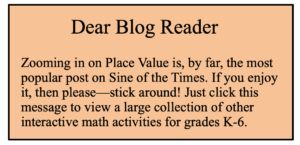One of the aspects I like best about Dynamic Geometry software like Web Sketchpad is its ability to illustrate concepts that cannot effectively be represented with static media. Take, for example, a number line that we draw on a white board. Showing the number … Continue Reading ››
Tag Archives: Dynamic Number
Dancing Unknowns: You Haven’t Seen Simultaneous Equations Like These!
When it comes to simultaneous equations, I like to push the bounds of conventional pedagogical wisdom. In an earlier post, I offered a puzzle in which elementary-age students solve for four unknowns given eight equations. Now, I'd like to present a puzzle that might sound even more audacious: Solving for ten unknowns. … Continue Reading ››
Covering Your Bases: An Interactive Dials Model
There are certain topics in mathematics education not appropriate for polite discussion. Number bases other than 10 fit this category well, perhaps because of their association with the maligned "new math" of the 1960s. That's a shame because there is a lot to learn from them, especially when presented as interactive puzzles.
Below (and here) are … Continue Reading ››
Dilation Challenges
For a while now, I’ve been intrigued by the ways in which the study of geometric transformations can provide students with a very effective introduction to function concepts. Daniel and I have written a couple of articles about this topic, and we created a number of activities to take advantage of what can arguably be … Continue Reading ››
Understand the Sine Function by Dancing It
In Where Mathematics Comes From, cognitive scientists George Lakoff and Rafael Nuñez assert that our understanding of abstract mathematical concepts relies upon our sensory-motor experiences:
“For the most part, human beings conceptualize abstract concepts in concrete terms, using ideas and modes of reasoning grounded in the sensory-motor system. The mechanism by which the … Continue Reading ››
Arranging Addends Puzzles
Arranging Addends is an interactive puzzle that I designed on a long bus ride through Alaska. The goal of the puzzle is to arrange the circles and the six numbers (1, 2, 4, 8, 16, and 32) so that three conditions are met simultaneously: The sum of the numbers in the green circle is 21, … Continue Reading ››
Experiments with a Color Calculator
In the 1970s, my childhood friend Tim owned an Activision console and a variety of game cartridges. Tim was the envy of our block, but no matter how much I enjoyed a rousing game of Pong, I knew that my electronic toy was even better. No, I didn't own the rival Atari game system: I … Continue Reading ››
Factor Patterns at Your Fingertips
Take a look at the interactive model below (and here). Most of the numbers in the array are shaded orange, but several are blue. What is special about these blue values? They are the factors of 32, the largest number in the array.
Try dragging the red point to change the dimensions of the array. … Continue Reading ››
The Wavy Wavy Bridge
At the 2013 Baltimore Regional NCTM Meeting, I gave a presentation on Picturing Functions and Functions of Pictures. In the description of my presentation I’d promised to show how to use Sketchpad to create special effects, so when it came time to prepare, I figured I needed to deliver on my promise.
So I wrote a … Continue Reading ››
Learn to Multiply Like No Bunny’s Business
It started with an unassuming bunny that hopped along a number line.
 In 2011, our team at KCP Technologies released Sketchpad Explorer for the iPad, making it possible for teachers and students to interact with desktop Sketchpad models on their iPads.
In 2011, our team at KCP Technologies released Sketchpad Explorer for the iPad, making it possible for teachers and students to interact with desktop Sketchpad models on their iPads.
We were thrilled to bring the iPad’s … Continue Reading ››
